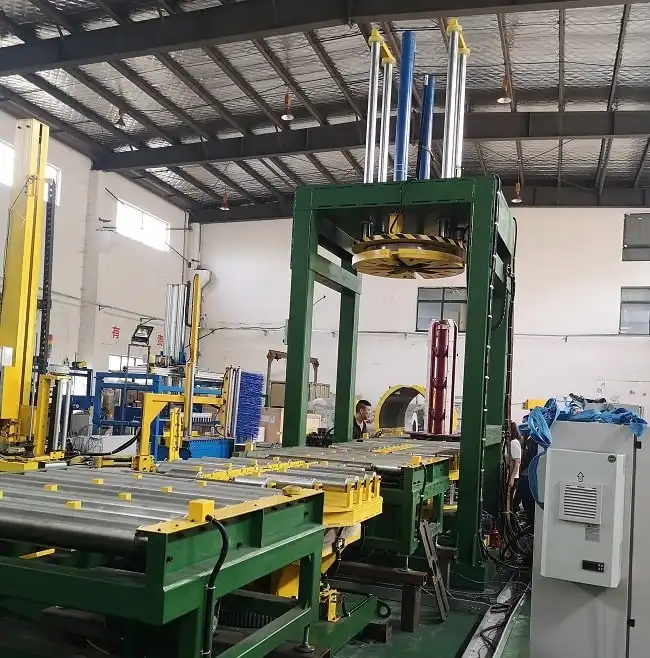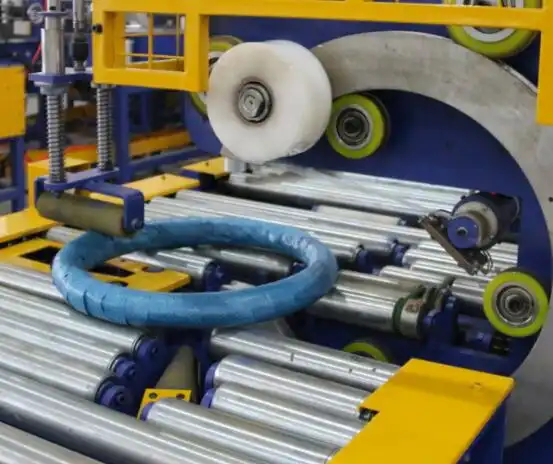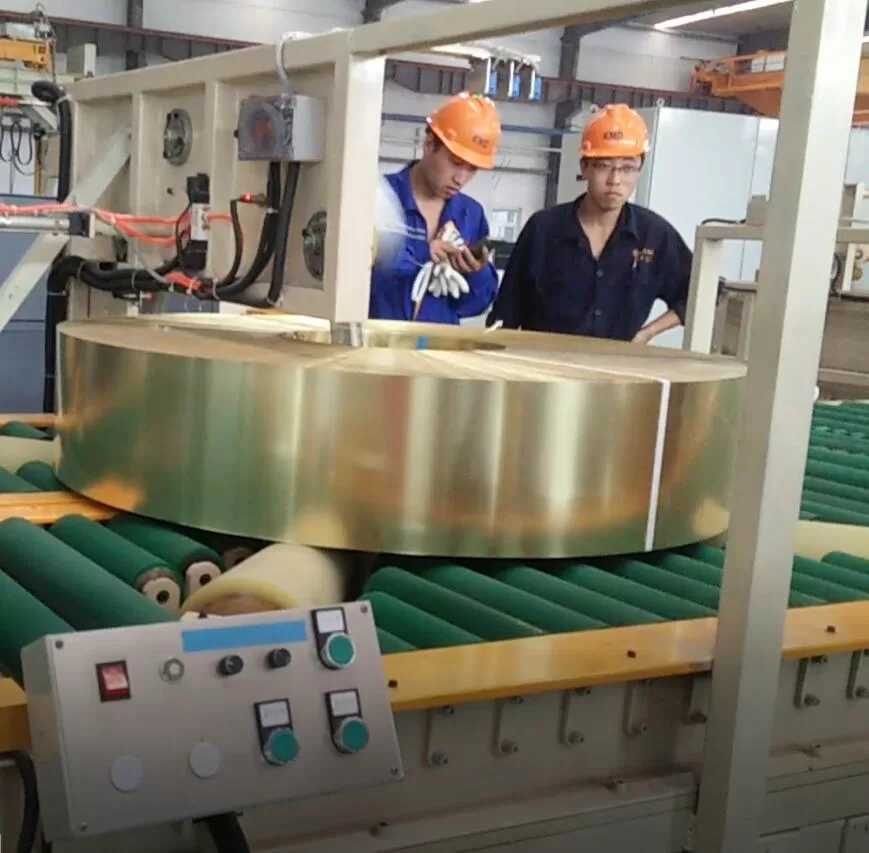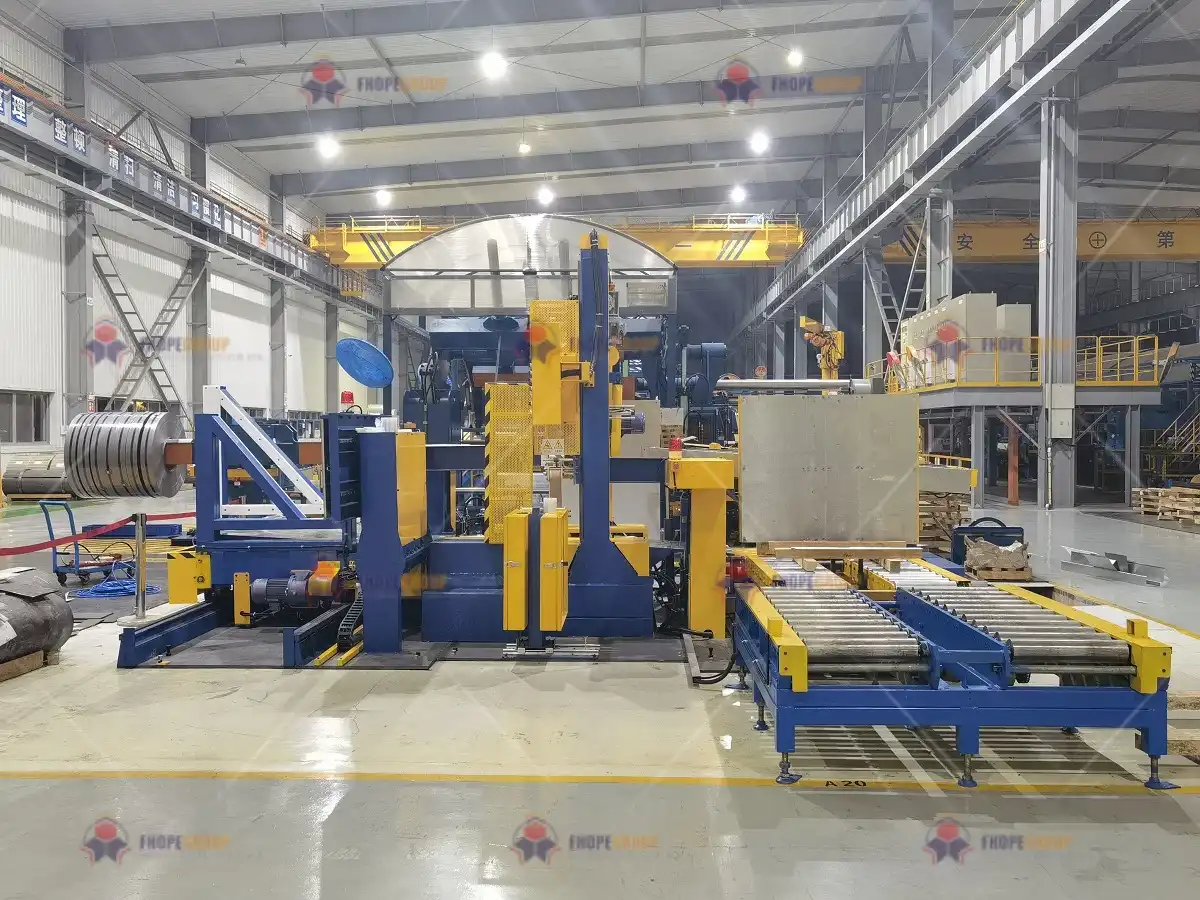Are you running a steel mill, constantly fighting against rising costs and aging equipment? You know that every investment must be perfect. A new packing line seems like a simple purchase, but making the wrong choice can lead to years of hidden costs, frustrating downtime, and production bottlenecks. You look at your balance sheet, see the thin margins, and feel the pressure to make a decision that not only solves today's problems but also prepares your factory for the future.
For 2025, the best-selling coil packing lines in competitive markets like Spain are not just machines; they are fully integrated systems. These lines are defined by high levels of automation, exceptional energy efficiency through smart technology, and seamless data connectivity with factory-wide MES and ERP platforms. Their core purpose is to maximize uptime, minimize operational costs, and provide the data needed for intelligent, proactive management.

That’s the quick summary. But as a business owner, you know the devil is in the details. You need to understand why these trends are happening and how they directly impact your bottom line. I’m Vincent Liu, and I’ve walked this path. I went from being an engineer on the factory floor to building my own packing machine company, SHJLPACK. I’ve seen what works and what doesn't. Let’s break down what a top-tier 2025 packing line really looks like, so you can make an investment that pays you back for years to come.
How are Spanish steel mills tackling rising energy costs with their packing lines?
You see the electricity and fuel bills every month. They are unpredictable and can erase your hard-won profits. It feels like a battle you can't win. This volatility makes it incredibly difficult to forecast costs and maintain a competitive edge. So, you start looking for savings in every corner of your operation, and you might be surprised to find that your packing line, often overlooked, can be a source of significant energy waste or a tool for major savings.
To combat this, Spanish steel mills are now demanding packing lines engineered for extreme energy efficiency. The solution lies in smart design and modern components. They are specifying machines with variable frequency drives (VFDs) on all major motors, energy-regenerative systems on braking mechanisms, and intelligent software that optimizes every movement. This approach turns a traditionally power-hungry machine into a lean, cost-effective asset.

Dive Deeper: The Anatomy of an Energy-Efficient Packing Line
When I design a machine for a client concerned about energy, we don't just look at the main motor. We analyze the entire system from the ground up. For a CEO like you, Javier, who is targeting a 10% reduction in unit energy consumption, understanding these details is crucial. It's the difference between a simple claim on a brochure and real, measurable savings on your monthly power bill.
Key Energy-Saving Components
-
Variable Frequency Drives (VFDs): Think of an old machine like a light switch—it's either on full power or off. A VFD acts like a dimmer switch for a motor. It provides the exact amount of power needed for a specific task. When the wrapping ring is accelerating, it gets full power. When it's running at a steady speed, it uses less. During short pauses, power consumption drops dramatically. This alone can cut the motor's energy use by 20-50% compared to a traditional direct-on-line motor.
-
Regenerative Braking Systems: In a typical packing line, when the large wrapping ring needs to slow down, the kinetic energy is converted into heat by a braking resistor and wasted. It's like slamming on the brakes in your car. A regenerative system captures that kinetic energy and converts it back into usable electricity, feeding it back into the machine's power circuit. It's a small gain on each cycle, but when you're packing hundreds of coils a day, this adds up to thousands of kilowatt-hours saved per year.
-
Optimized Mechanical Design: Efficiency is also about physics. We use lightweight, high-strength alloys for the rotating ring to reduce inertia. Lower inertia means the motor needs less energy to start and stop it. We also use high-efficiency gearboxes and low-friction bearings. Every point of resistance we engineer out of the system is a direct reduction in the power required to run it.
Here is a simple comparison of what leading Spanish mills are leaving behind versus what they are adopting for 2025.
| Feature | Old Technology (Pre-2015) | 2025 Spanish Standard | Impact on Your Goals |
|---|---|---|---|
| Main Motor Drive | Direct-on-line (DOL) starter | Variable Frequency Drive (VFD) | Directly lowers electricity consumption, helps achieve 10% energy reduction goal. |
| Braking System | Dynamic braking with resistors | Regenerative braking system | Recycles energy, further reducing net power draw and contributing to cost savings. |
| Mechanicals | Heavy steel components, standard bearings | Lightweight alloys, low-friction design | Less motor strain, lower power needs, and reduced wear and tear on parts. |
| Operation Logic | Fixed speed, one-size-fits-all cycle | Smart sensors, adaptive cycle speed | Eliminates wasted energy by tailoring power use to each specific coil. |
This systematic approach is how you achieve a meaningful reduction in your unit product energy consumption. It’s not one magic bullet; it’s a series of intelligent engineering choices.
What automation features are essential for achieving 95% uptime in 2025?
Every minute of unplanned downtime on your packing line can cause a major backlog. It stops your entire production flow, delays shipments, and frustrates your team. You have an ambitious goal of 95% effective run time, but your aging equipment with its frequent, unpredictable failures makes this seem impossible. You feel like your maintenance team is always putting out fires instead of preventing them.
To solve this, leading mills are investing in intelligent automation designed specifically to maximize reliability and minimize downtime. The essential features for 2025 are not just about replacing labor, but about eliminating sources of failure. This includes systems for automatic fault diagnosis, predictive maintenance alerts based on real-time sensor data, and modular components that can be replaced in minutes, not hours. This is how you move from a reactive maintenance culture to a proactive, predictive one.

Dive Deeper: Engineering for Near-Constant Operation
Achieving 95% uptime isn't about hope; it's about a strategy built into the machine's design. When a client tells me they cannot afford downtime, I focus on two areas: preventing failures before they happen and making recovery instant when they do. This proactive approach is fundamental to hitting that 95% target.
From Reactive to Predictive Maintenance
The biggest shift is moving away from waiting for something to break. A 2025-ready line is covered in smart sensors that act as a nervous system.
- Vibration Sensors: These are mounted on major motor and bearing housings. They constantly monitor the vibration signature. Our software knows the "healthy" signature. If a bearing starts to wear out, its vibration pattern changes long before it fails. The system flags this, sending an alert to maintenance: "Check bearing on motor 3 within the next 48 hours." Your team can then schedule the replacement during planned downtime, avoiding a catastrophic failure during a production run.
- Temperature Sensors: Overheating is a primary sign of trouble in motors, gearboxes, and electrical cabinets. The system tracks temperature trends. A gradual increase over days or weeks points to a problem like poor lubrication or electrical resistance, allowing for a proactive fix.
- Motor Current Monitoring: The PLC continuously monitors the electrical current drawn by each motor. A sudden spike or a gradual increase can indicate a mechanical jam, increased friction, or a failing component. This can automatically trigger a safe stop to prevent damage and pinpoint the exact location of the problem for the maintenance crew.
Automation That Eliminates Human Error and Delays
Many downtime events are caused by small, repeatable human errors or slow manual processes. Automation targets these weak points directly.
| Process | Typical Manual/Semi-Auto Method | Fully Automated 2025 Method | Impact on Uptime |
|---|---|---|---|
| Fault Finding | Operator searches for the problem. Calls maintenance. A technician diagnoses. (30-60 mins) | HMI screen displays the exact fault, its location, and suggested steps to fix it. (2-5 mins) | Drastically reduces Mean Time To Repair (MTTR). |
| Film Roll Change | Machine stops. Operator manually cuts old film, removes empty spool, loads new roll, and re-threads film. (5-10 mins) | System detects low film level, automatically splices the end of the old roll to a new one without stopping. (0 mins downtime) | Eliminates a common and frequent source of stoppage. |
| Coil Centering | Operator uses a joystick or buttons to position the coil. Misalignment can cause wrapping issues. (1-2 mins) | Laser or vision sensors automatically detect the coil's position and adjust the machine for a perfect wrap every time. | Prevents errors that lead to rework and downtime. |
By combining predictive data with smart automation, the machine essentially takes care of itself and gives your team the tools to act before a crisis. This is the only realistic path to achieving and sustaining 95% uptime in a demanding steel mill environment.
How do modern coil packing lines integrate with digital factory systems (MES/IoT)?
You are trying to build a truly smart factory, but you're struggling with "islands of automation." Your furnace has one system, your rolling mill has another, and your packing area has nothing. You can't get a clear, real-time picture of your entire operation, making it hard to track costs, identify bottlenecks, and make data-driven decisions. You know you need a fully visible production process, but getting your machines to talk to each other is a major challenge.
Modern coil packing lines are designed to solve this problem. They are no longer isolated machines but are built as native "citizens" of a digital factory. The key is their ability to communicate seamlessly using open standards like OPC-UA. They act as rich data sources, feeding crucial information—like cycle times, material consumption, coil IDs, and error codes—directly into your Manufacturing Execution System (MES) or ERP platform. This integration provides the complete production visibility you need.

Dive Deeper: The Packing Line as a Central Data Hub
For a leader like you, Javier, who is focused on a full digital transformation, the packing line should be one of your most valuable data sources. It's the final step before the product leaves your control. The data it generates provides the "full stop" on the production story of each coil. Here’s a breakdown of how a 2025-spec line achieves this and why that data is critical for your business goals.
What Does "Integration-Ready" Actually Mean?
It comes down to two things: hardware and software.
- Hardware: A modern packing line's control panel has a standard industrial Ethernet port, just like an office computer. It’s not a complex, proprietary connection. It’s designed to be plug-and-play with your factory network.
- Software (The Protocol): The machine's PLC (Programmable Logic Controller) speaks a universal language. The most common and powerful one today is OPC-UA (Open Platform Communications Unified Architecture). Think of it as the "English" of factory machines. It allows your packing line to talk to systems from Siemens, Rockwell, SAP, or any other major vendor without expensive custom programming.
The Data That Transforms Your Operations
Once connected, the packing line provides a constant stream of data to your central MES platform. Here are the key data points and how they help you achieve your goals:
| Data Point | What It Is | How It Helps You Manage |
|---|---|---|
| Coil ID (Scanned) | The unique barcode or tag on each coil, read automatically. | Traceability: Links the final package to all upstream production data. If a customer has an issue, you can trace its entire history in seconds. |
| Wrapping Recipe Used | The specific program used (e.g., "Export Grade," "Domestic Standard"). | Quality Control: Ensures every coil is packed exactly to specification. Prevents costly errors from using the wrong materials or wrap density. |
| Wrapping Film Consumed | The exact length of film used for each coil, measured in meters. | Cost Control: Allows you to track packaging material costs with perfect accuracy. Helps you meet your 8% cost reduction goal. |
| Cycle Time | The time from when the coil enters to when it exits the machine. | Efficiency Analysis: Identifies bottlenecks. If cycle times start increasing, it signals a problem before it impacts overall plant throughput. |
| Downtime/Error Codes | Every time the machine stops, it logs the reason (e.g., "E-Stop Pressed," "Film Break," "Guard Door Open"). | Root Cause Analysis: Provides real data for your maintenance and operations teams to permanently solve recurring problems. |
This seamless flow of information from the packing line to your dashboard is the foundation of a digital factory. It allows you to see what’s happening, understand why it's happening, and make informed decisions to improve performance and lower costs.
My Insight: Why a "Machine" is Never Just a Machine
You’re preparing to make a significant capital investment. The natural fear is that once the check is cashed and the machine is delivered, you're on your own. You’re left with a piece of equipment that doesn't quite fit your workflow and a supplier who is suddenly very hard to reach. I have seen this happen too many times. It's a transactional approach, and it almost always fails the customer.
I built SHJLPACK on a completely different philosophy, one born from my own journey. A machine is not the end of the transaction; it is the beginning of a partnership. A true "Total Solution" for 2025 goes far beyond the physical hardware. It is a commitment from a partner to understand your challenges, design a system that solves them, and stand by you to ensure that the equipment delivers on its promise of higher efficiency, lower costs, and better reliability.

Dive Deeper: The Four Phases of a Strategic Partnership
When a steel mill owner like you, Javier, comes to me, my first goal isn't to sell you a model from my catalog. It's to understand your strategic objectives: 95% uptime, 10% energy reduction, 8% cost savings, and full digital integration. The machine is simply the tool we use to achieve those goals together. This process unfolds in distinct phases.
Phase 1: Pre-Sale Consultation & Design
This is the most critical phase. We don't just talk about the packing machine; we talk about your entire end-of-line process. How do coils arrive? By crane or conveyor? What are their size ranges? What is the floor space? We use this information to design not just the machine, but the entire workflow around it. This might mean suggesting a change in the conveyor layout to prevent bottlenecks or designing a custom entry/exit system. This ensures the solution fits your factory, not the other way around.
Phase 2: Transparent Manufacturing & Integration
During manufacturing, we see you as a partner. We provide progress updates and, most importantly, we plan the integration. Our software engineers will talk directly to your IT or MES team. We’ll discuss the data points you need and ensure the communication protocols are set up correctly before the machine even leaves our factory. This proactive work avoids weeks of frustrating integration problems on-site.
Phase 3: On-Site Installation & Deep Training
Our job isn’t done when the truck arrives. Our engineers are on-site for installation, commissioning, and training. We don't just train one operator; we train your operators, your maintenance staff, and your supervisors. The operators learn how to run it efficiently. The maintenance team learns the predictive maintenance system, how to interpret alerts, and how to perform key service tasks. This empowers your team to own the equipment from day one.
Phase 4: Long-Term Proactive Support
This is what a partnership is all about. With the machine connected to the internet (with your permission), our support team can remotely diagnose issues, often before your team even notices a problem. When a predictive maintenance alert is triggered, we can analyze the data and provide your team with specific advice. We manage your spare parts strategy and suggest upgrades as new technology becomes available. This ongoing collaboration is how we help you achieve and exceed a goal like an 8% reduction in operating costs over the long term.
A machine is an expense. A total solution is a strategic investment in your factory's future profitability and stability.
Conclusion
Choosing a 2025 packing line means investing in automation, efficiency, and data. A true partner helps you integrate these elements, ensuring long-term success and profitability for your operations.





